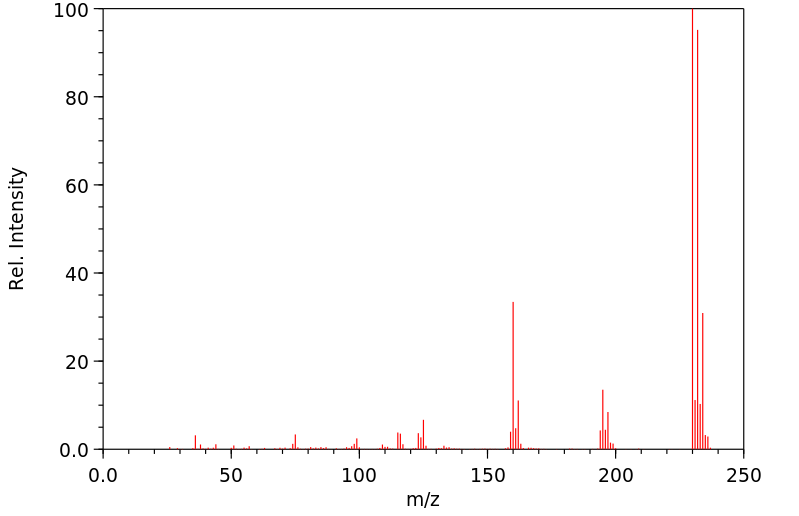2,3,6-三氯萘 | 55720-40-6
中文名称
2,3,6-三氯萘
中文别名
——
英文名称
2,3,6-trichloronaphthalene
英文别名
2,3,6-trichloro-naphthalene;2,3,6-Trichlor-naphthalin;2,3,6-Trichlornaphthalin
CAS
55720-40-6
化学式
C10H5Cl3
mdl
——
分子量
231.509
InChiKey
ZYTLBFKRYKUCMJ-UHFFFAOYSA-N
BEILSTEIN
——
EINECS
——
-
物化性质
-
计算性质
-
ADMET
-
安全信息
-
SDS
-
制备方法与用途
-
上下游信息
-
文献信息
-
表征谱图
-
同类化合物
-
相关功能分类
-
相关结构分类
物化性质
-
熔点:84 °C - 86 °C
-
溶解度:可溶于氯仿(少许)、甲醇(少许)
-
保留指数:1821.2
计算性质
-
辛醇/水分配系数(LogP):5.1
-
重原子数:13
-
可旋转键数:0
-
环数:2.0
-
sp3杂化的碳原子比例:0.0
-
拓扑面积:0
-
氢给体数:0
-
氢受体数:0
SDS
反应信息
-
作为反应物:参考文献:名称:43.衍生自四氯化二氯萘和三氯萘磺酸的四氯萘摘要:DOI:10.1039/jr9410000243
-
作为产物:描述:参考文献:名称:De Novo Synthesis Mechanism of Polychlorinated Dibenzofurans from Polycyclic Aromatic Hydrocarbons and the Characteristic Isomers of Polychlorinated Naphthalenes摘要:Polychlorinated dibenzofurans (PCDFs) and polychlorinated naphthalenes (PCNs) are known to be emitted from municipal waste incinerators (MWIs) with polychlorinated dibenzo-p-dioxins (PCDDs). Two formation paths for PCDD/Fs could mainly work, which are condensation of the precursors such as chlorophenols and "de novo" formation from carbon. However the correlation between the chemical structure of carbon and the resulting PCDD/Fs still remains unknown. In this study, the PCDD/Fs formation from polycyclic aromatic hydrocarbons (PAHs) and CuCl was examined at 400 under 10% O-2. Coronene among the PAHs characteristically gave 1,2,8,9-T4CDF and the derivatives. These isomers clearly indicate that chlorination causes the cleavage of the C-C bonds in a coronene molecule and also that oxygen is easily incorporated from its outside to form 1,2,8,9-T4CDF. The symmetrical preformed structures in the coronene molecule enabled to amplify the de novo formation of the isomer. PCNs are also formed directly from these PAHs. Since there have been few reports on the formation mechanism of PCNs, this study will be a first step to know the whole formation paths. We also define the de novo synthesis as the breakdown reaction of a carbon matrix, since the word has been used without the precise definition.DOI:10.1021/es980857k
文献信息
-
Analgesic carboxylic acid amide derivatives申请人:Sankyo Company Limited公开号:EP0356247A1公开(公告)日:1990-02-28Analgesic compounds are of the general formula (I): in which, R¹ and R² each represents hydrogen or C₁-C₆ alkyl, or R¹ and R² together with the nitrogen atom to which they are attached form a heterocycle; E represents methylene, sulphur, oxygen or imino group optionally substituted with C₁-C₆ alkyl or aralkyl; ring A is aryl or heteroaryl ring, optionally substituted; R³ is hydrogen or C₁-C₆ alkyl and R⁴ is hydrogen or R³ and R⁴ together represent a group of formula (IV): -(CRaRa)m-C(=Y)- (IV) (wherein Ra and Ra is C₁-C₆ alkyl or hydrogen, up to a maximum of 3 alkyl groups, m is 1, 2, or 3, and Y is two hydrogens or oxygen); provided that when E represents a methylene group, then R³ is a C₁-C₆ alkyl group or R³ and R⁴ together represent a group of the formula (IV).
-
Franzen; Staeuble, Journal fur praktische Chemie (Leipzig 1954), 1921, vol. <2> 103, p. 367作者:Franzen、StaeubleDOI:——日期:——
-
Armstrong; Wynne, Chemical news and journal of industrial science, 1890, vol. 62, p. 163作者:Armstrong、WynneDOI:——日期:——
-
Armstrong; Wynne, Chemical news and journal of industrial science, 1890, vol. 61, p. 93作者:Armstrong、WynneDOI:——日期:——
-
Armstrong; Wynne, Chemical news and journal of industrial science, 1890, vol. 61, p. 273作者:Armstrong、WynneDOI:——日期:——
表征谱图
-
氢谱1HNMR
-
质谱MS
-
碳谱13CNMR
-
红外IR
-
拉曼Raman
-
峰位数据
-
峰位匹配
-
表征信息
同类化合物
(S)-溴烯醇内酯
(R)-3,3''-双([[1,1''-联苯]-4-基)-[1,1''-联萘]-2,2''-二醇
(3S,3aR)-2-(3-氯-4-氰基苯基)-3-环戊基-3,3a,4,5-四氢-2H-苯并[g]吲唑-7-羧酸
(3R,3’’R,4S,4’’S,11bS,11’’bS)-(+)-4,4’’-二叔丁基-4,4’’,5,5’’-四氢-3,3’’-联-3H-二萘酚[2,1-c:1’’,2’’-e]膦(S)-BINAPINE
(11bS)-2,6-双(3,5-二甲基苯基)-4-羟基-4-氧化物-萘并[2,1-d:1'',2''-f][1,3,2]二氧磷
(11bS)-2,6-双(3,5-二氯苯基)-4羟基-4-氧-二萘并[2,1-d:1'',2''-f][1,3,2]二氧磷杂七环
(11bR)-2,6-双[3,5-双(1,1-二甲基乙基)苯基]-4-羟基-4-氧化物-二萘并[2,1-d:1'',2''-f][1,3,2]二氧杂磷平
黄胺酸
马兜铃对酮
马休黄钠盐一水合物
马休黄
食品黄6号
食品红40铝盐色淀
飞龙掌血香豆醌
颜料黄101
颜料红70
颜料红63
颜料红53:3
颜料红5
颜料红48单钠盐
颜料红48:2
颜料红4
颜料红261
颜料红258
颜料红220
颜料红22
颜料红214
颜料红2
颜料红19
颜料红185
颜料红184
颜料红170
颜料红148
颜料红147
颜料红146
颜料红119
颜料红114
颜料红 9
颜料红 21
颜料橙7
颜料橙46
颜料橙38
颜料橙3
颜料橙22
颜料橙2
颜料橙17
颜料橙 5
颜料棕1
顺式-阿托伐醌-d5
雄甾烷-3,17-二酮







